Biography
He came from a large family of craftsmen. From 1890 to 1893, he studied basic painting with Johann Caspar Herterich and "en plein aire" techniques with Paul Hoecker at the Academy of Fine Arts, Munich.
In 1894, he worked as an art teacher and illustrator in St. Gallen. From 1897 to 1899, he made a study trip to Paris, Rome, and the village of Terracina. He was offered a professorship at the Kunstakademie Düsseldorf in 1901, but declined.
He married Cécile Bernet, the daughter of a textile merchant, in 1902. They had five children, including the painter, Carl Walter Liner (sometimes called "Junior"). In 1906 he acquired a farm not far from Appenzell and operated it until 1930, when he purchased an estate. In 1913, at the suggestion of Ferdinand Hodler, he founded the St.Gallen branch of the GSMBA (Gesellschaft Schweizerischer Maler und Bildhauer [ de ]). He was elected President of the GSMBA Executive Board in 1928, but quit in 1931 over issues related to politics.
In addition to his paintings, he designed postage stamps and posters and did illustrations. It was this work that provided most of his income. He was also an amateur inventor and holds the patent for an early version of the single-axis mower (forerunner of the present rotary mowers). It wasn't until the 1930s that his paintings began to earn money. In 1934, he made a trip to Egypt to do portraits, commissioned by the firm of Reinhart & Schmidheiny [ de ].
For many years, he had suffered from bone tuberculosis and, by 1940, his health had deteriorated to the point that work was nearly impossible. In 1942, he became paralyzed from the waist down and was permanently hospitalized.
Major retrospectives were held in 1983 (Pfäffikon) and 1996 (Appenzell). To honor him and his son, who died in 1997, the "Museum Liner Appenzell" was opened in 1998. It has since been renamed the Kunstmuseum Appenzell [ de ].

The Abbey of Saint Gall is a dissolved abbey (747–1805) in a Catholic religious complex in the city of St. Gallen in Switzerland. The Carolingian-era monastery existed from 719, founded by Saint Othmar on the spot where Saint Gall had erected his hermitage. It became an independent principality between 9th and 13th centuries, and was for many centuries one of the chief Benedictine abbeys in Europe. The library of the Abbey is one of the oldest monastic libraries in the world.
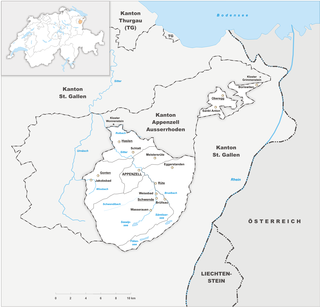
Appenzell Innerrhoden, in English sometimes Appenzell Inner-Rhodes, is one of the 26 cantons forming the Swiss Confederation. It is composed of six districts. The seat of the government and parliament is Appenzell. It is traditionally considered a "half-canton", the other half being Appenzell Ausserrhoden.

Appenzell Ausserrhoden, in English sometimes Appenzell Outer Rhodes, is one of the 26 cantons forming the Swiss Confederation. It is composed of twenty municipalities. The seat of the government and parliament is Herisau, and the seat of judicial authorities are in Trogen. It is traditionally considered a "half-canton", the other half being Appenzell Innerrhoden.

Trogen is a municipality in the canton of Appenzell Ausserrhoden in Switzerland. The town is the seat of the canton's judicial authorities.

The canton of St. Gallen or St Gall is a canton of Switzerland. Its capital is St. Gallen.

Rorschach is a municipality, in the District of Rorschach in the canton of St. Gallen in Switzerland. It is on the south side of Lake Constance (Bodensee).

St. Gallen is a Swiss city and the capital of the canton of St. Gallen. It evolved from the hermitage of Saint Gall, founded in the 7th century. Today, it is a large urban agglomeration and represents the center of eastern Switzerland. Its economy consists mainly of the service sector. The city is home to the University of St. Gallen, one of the best business schools in Europe.

Ferdinand Hodler was a Swiss painter. He is one of the best-known Swiss painters of the nineteenth century. His early works were portraits, landscapes, and genre paintings in a realistic style. Later, he adopted a personal form of symbolism which he called "parallelism".
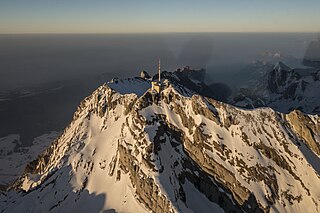
At 2,501.9 metres (8,208 ft) above sea level, Säntis is the highest mountain in the Alpstein massif of northeastern Switzerland. It is also the culminating point of the whole Appenzell Alps, between Lake Walen and Lake Constance. Shared by three cantons, the mountain is a highly visible landmark thanks to its exposed northerly position within the Alpstein massif. As a consequence, houses called Säntisblick can be found in regions as far away as the Black Forest in Germany. Säntis is among the most prominent summits in the Alps and the most prominent summit in Europe with an observation deck on the top. The panorama from the summit is spectacular. Six countries can be seen if the weather allows: Switzerland, Germany, Austria, Liechtenstein, France, and Italy.

Carl Eduard Ferdinand Blechen was a German landscape painter and a professor at the Academy of Arts, Berlin. His distinctive style was characteristic of the Romantic ideals of natural beauty.
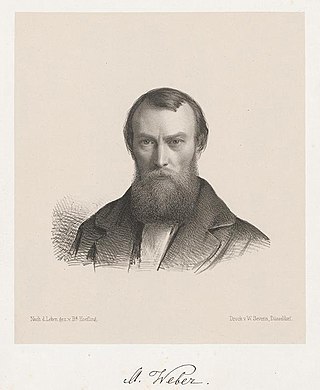
Johann Baptist Wilhelm August Weber was a German painter; associated with the Düsseldorfer Malerschule.

Markus Zürcher was a Swiss painter and representative of conceptual art and minimalism.

Adrian Zingg was a Swiss painter.
Willi Dreesen was a Swiss painter and sculptor.
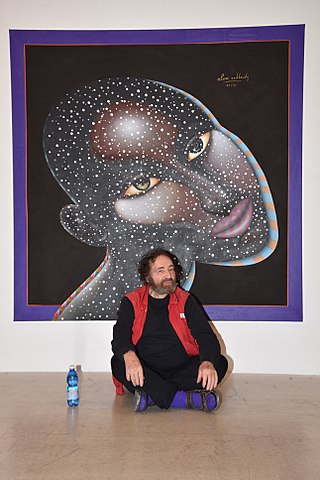
Alex Sadkowsky is a Swiss artist, painter, illustrator, graphic artist, photographer, performer, and author.

The Appenzell–St. Gallen–Trogen railway, also known as the Durchmesserlinie, is a metre gauge overland tramway in the Swiss cantons of Appenzell Innerrhoden and Ausserrhoden and the city of St. Gallen. It is the steepest adhesion railway in Switzerland with a gradient of up to 8.0% and forms part of the network of the Appenzell Railways (AB) and the St. Gallen S-Bahn. The line's two branches were completed in sections between 1889 and 1904 by the St. Gallen-Gais-Appenzell-Altstätten Railway and the Trogen Railway. The two lines were connected by the AB with a cross-city route in 2018.
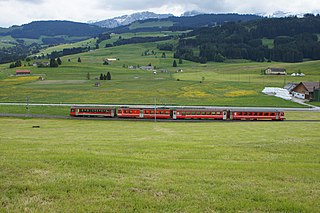
The Gossau–Wasserauen railway line is a metre-gauge adhesion railway of the Appenzell Railways. It runs from Gossau via Appenzell to Wasserauen in Switzerland and is given the abbreviation of GAW by the operator. The connection was built and electrified in several stages by different companies and has been operating continuously since 1949.
Fritz Nathan was a German-Swiss gallery owner and art dealer.
Carl Christoph Friedrich Bernoulli was a Swiss art dealer and interior designer from the Bernoulli family of scholars.

Constant Könz is a Swiss painter, architect, and sgraffito artist. He is known for decorating houses in sgraffito all over Graubünden.
This page is based on this
Wikipedia article Text is available under the
CC BY-SA 4.0 license; additional terms may apply.
Images, videos and audio are available under their respective licenses.


















